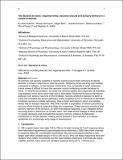The decision to move : response times, neuronal circuits and sensory memory in a simple vertebrate
Abstract
All animals use sensory systems to monitor external events and have to decide whether to move. Response times are long and variable compared to reflexes, and fast escape movements. The complexity of adult vertebrate brains makes it difficult to trace the neuronal circuits underlying basic decisions to move. To simplify the problem, we investigate the nervous system and responses of hatchling frog tadpoles which swim when their skin is stimulated. Studying the neuron-by-neuron pathway from sensory to hindbrain neurons, where the decision to swim is made, has revealed two simple pathways generating excitation which sums to threshold in these neurons to initiate swimming. The direct pathway leads to short, and reliable delays like an escape response. The other includes a population of sensory processing neurons which extend firing to introduce noise and delay into responses. These neurons provide a brief, sensory memory of the stimulus, that allows tadpoles to integrate stimuli occurring within a second or so of each other. We relate these findings to other studies and conclude that sensory memory makes a fundamental contribution to simple decisions and is present in the brainstem of a basic vertebrate at a surprisingly early stage in development.
Citation
Roberts , A , Borisyuk , R , Buhl , E , Ferrario , A , Koutsikou , S , Li , W-C & Soffe , S R 2019 , ' The decision to move : response times, neuronal circuits and sensory memory in a simple vertebrate ' , Proceedings of the Royal Society B: Biological Sciences , vol. 286 , no. 1899 , 20190297 . https://doi.org/10.1098/rspb.2019.0297
Publication
Proceedings of the Royal Society B: Biological Sciences
Status
Peer reviewed
ISSN
0962-8452Type
Journal item
Collections
Items in the St Andrews Research Repository are protected by copyright, with all rights reserved, unless otherwise indicated.

